Friday, 9 December 2011
Jolly Phonics
Introduction to Jolly Phonics
What is Jolly Phonics?
Jolly Phonics is a fun and child centred approach to teaching literacy. With actions for each of the 42 letter sounds, the multi-sensory method is very motivating for children and teachers, who can see their students achieve. The letter sounds are split into seven groups as shown below.Letter Sound Order
The sounds are taught in a specific order (not alphabetically). This enables children to begin building words as early as possible.How does Jolly Phonics work?
Using a synthetic phonics approach, Jolly Phonics teaches children the five key skills for reading and writing. Complemented by Jolly Readers and Jolly Grammar, it provides a thorough foundation for teaching literacy over three years in school.The five skills taught in Jolly Phonics

1.Learning the letter sounds
Children are taught the 42 main letter sounds. This includes alphabet sounds as well as digraphs such as sh, th, ai and ue.
2.Learning letter formation
Using different multi-sensory methods, children learn how to form and write the letters.
3.Blending
Children are taught how to blend the sounds together to read and write new words.
4.Identifying the sounds in words
Listening for the sounds in words gives children the best start for improving spelling.
5.Tricky words
Tricky words have irregular spellings and children learn these separately.
Thursday, 1 December 2011
Saturday, 19 November 2011
Wednesday, 9 November 2011
Monday, 24 October 2011
Teaching Alphabet Sounds
Help Your Child Improve Auditory Skills by Teaching Alphabet Letter Sounds
In order to read, every child must know the sounds of the alphabet letters. He must be able to recall them quickly - he sees the letter and says the sound without hesitation.
- Test your
child's knowledge of alphabet letter sounds by using the provided Alphabet List. Point to
each letter and ask your child to, "Tell me what this letter
says."
*The alphabet list has no pictures, so your child has to rely totally on memory.
*You are asking your child to tell you the letter sound, not the letter name.
*Write down letter sounds that he or she misses. This is a good place to begin fixing your child's auditory gaps. - If your child needs to learn most of the alphabet letter sounds, help her create her own Alphabet Book. Staple some pieces of paper together and ask your child to draw pictures of items that begin with the sound of each alphabet letter.
- You can also
teach alphabet letters and letter sounds by using an Alphabet Chart with
pictures.
*Be sure to point to each letter as you are saying the letter name and letter sound.
*Review the alphabet chart once a day and pretty soon your child will be able to point to each letter and say the sounds himself!
*I have an alphabet chart tacked on the wall at kid-height of my son's bedroom so he can look at it. - When you are teaching a letter sound, be careful not to add an "uh" sound at the end of the letter. For example, letter s should sound like a snake hissing, with no throat sound. Letter s says 'sss,' not 'suh.' If your child learns letters 'c', 'a', 't' as sounding 'kuh,' 'aah,' and 'tuh,' those sounds will not come together to say cat!
Children have different learning rates. Your child may need lots of direct instruction to learn the alphabet sounds. Don't forget, he will learn letter sounds more quickly with a short daily review.
Saturday, 15 October 2011
Wednesday, 12 October 2011
Phonics Games
Phonics games will help your child to practise sounding out words, which will help them to read. Initially,
children will learn basic letter sounds, such as "c-a-t" for "cat". Later they will move on to sounds such as "th",
"sh" and "ch", then "oo", "oa" and so on. Once they recognise a few basic letter sounds, they will be able to work
out what a written word says for themselves, a skill which they will be very proud to show off!
Follow the links below to the free phonics games. Your child will have lots of fun while developing their phonic knowledge and skills.
Follow the links below to the free phonics games. Your child will have lots of fun while developing their phonic knowledge and skills.
|
||||||||||||
|
|
|
|
|
|
|
|
|
|
Tuesday, 11 October 2011
Putting Sound Together
Help Your Child Put Sounds Together to Make Words by Playing "Connect Three."
This game will help your child connect sounds to make words. This skill is used when he sounds out new words.
How to Play:
- Tell your child, "I'm going to say three sounds. I want you to put the sounds together and say a word. For example, I say c-a-t and you say cat. I say d-o-g and you say dog." This is a little tricky on your part because you have to think of words that can be said in three parts. Words such as me or go won't work. Longer words such as party can be par-t-y or p-art-y. You might want to practice ahead of time to say words in three parts. I have trouble thinking of words, so I usually look around the room for good ideas such as l-am-p or win-d-ow.
- Here's a list to get you started: begin with nouns-things that can be visualized and advance to words that don't create mental pictures.
|
|
m-o-m
b-ir-d h-o-t h-i-m |
d-a-d
s-u-n gr-ee-n c-a-n |
d-e-sk
pi-zz-a dr-in-k w-i-ll |
br-ai-n
mo-n-ey c-ol-d a-n-d |
tr-e-e
c-am-p st-o-p b-u-t |
y-ar-d
t-en-t w-i-n fr-o-m |
Subscribe to:
Posts (Atom)








 Letters and Sounds Phase 2 Initial Sounds Match
Letters and Sounds Phase 2 Initial Sounds Match Sound Sea
Sound Sea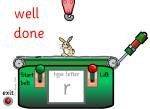 Letter Lifter
Letter Lifter Phoneme Pop
Phoneme Pop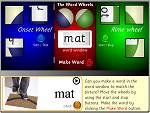 Word Wheel
Word Wheel Reading machine
Reading machine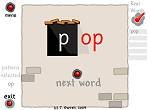 Three-letter house
Three-letter house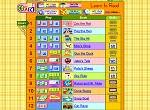 Starfall
Starfall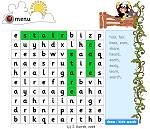 DJ Cows
DJ Cows Phonic Fighter
Phonic Fighter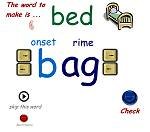 CVC Maker
CVC Maker